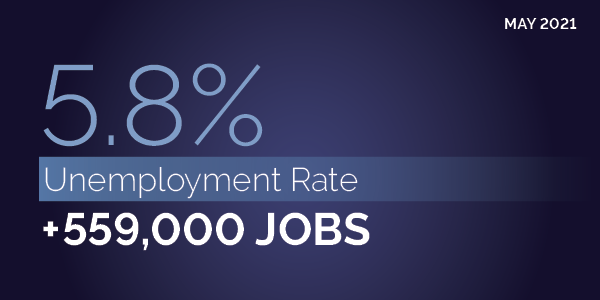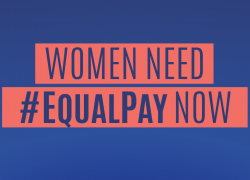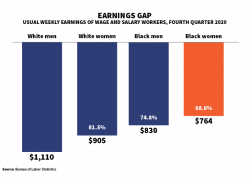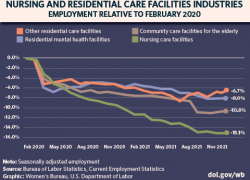
The economy added 559,000 jobs in May, the Bureau of Labor Statistics reported this morning, and the unemployment rate dropped from 6.1% to 5.8%. These are signs of steady, positive progress, slightly above what we’ve seen in recent months. While the unemployment rate is still higher than it was before the pandemic, we’re definitely moving in the right direction. Here are five numbers that help explain the current state of the American job market.
541,000
On average, the economy has added 541,000 jobs per month over the past three months, showing a true economic recovery in progress. Work opportunities are increasingly available and job seekers are feeling more optimistic as the economy continues to rebound. The pandemic is still affecting the economy, but this is significant, historic progress.
6%
More specifically, below 6% – as in: In May, the unemployment rate dropped below 6% for the first time since the pandemic started. And that drop is due to people finding work, not giving up on the search. That means employers and workers alike are feeling more confident.
431,000
The number of long-term unemployed (people who have been out of work for at least 27 weeks) dropped by 431,000 to 3.8 million in May – the biggest decline in the number of long-term unemployed since 2011. The total number of long-term unemployed is still 2.6 million higher than it was in February 2020, but this decrease is a positive indicator for workers suffering long term joblessness. These workers are usually among the last to feel the effects of economic recovery, and bringing them off the sidelines is good news for an inclusive recovery.
9.1%
While the overall unemployment rate has dropped, the rate for workers of color remains at crisis levels. The unemployment rate is 5.1% for white workers and 5.5% for Asian, but it’s much higher for Black and Hispanic workers, at 9.1% and 7.3%, respectively. These numbers represent real improvements, with a monthly decrease of Black unemployment from 9.7% to 9.1%, and a decrease in Hispanic unemployment from 7.9% to 7.3% – but while Black and Hispanic workers face unemployment rates at this level, we're still a long way from economic equity.
1.8 million
There are still 1.8 million fewer women in the labor force than there were in February 2020. There are a lot of different reasons for this, including discrimination and occupational segregation. Women, particularly women of color, were disproportionately represented in many of the sectors that were hit hardest by the pandemic. They’re also more likely to take on family caregiving responsibilities which, at the height of the pandemic, made it impossible for some women to continue working. As schools and childcare facilities reopen and as all industries continue to reopen, we can expect to see more opportunities for women – but we should be mindful that in the past, economic recovery has not affected all demographics equally.
The Biden-Harris administration has made historic investments in education, infrastructure and American workers, and we’re already seeing the results – but ongoing recovery will require more work to strengthen the foundations of our economy. The American Jobs Plan and American Families Plan will be essential for the ongoing recovery by providing more support for physical and caregiving infrastructure, pre-school, post-secondary education, and other programs that will strengthen the foundations of the American middle class.
Investing in vaccinations is one action helping Americans get back to work. As of June 2, 41% of Americans were fully vaccinated, and as that number climbs, more businesses are resuming normal operations and more people are resuming pre-pandemic spending habits. If you or someone you know needs a free ride and/or child care so you can get a vaccine, visit vaccines.gov.
We have made historic progress, but we still have more work to do. My colleagues at the Labor Department are working hard to empower and protect workers and ensure that the post-pandemic economy is inclusive, equitable and growing.
Janelle Jones is the chief economist of the U.S. Department of Labor.

 U.S. Department of Labor Blog
U.S. Department of Labor Blog



